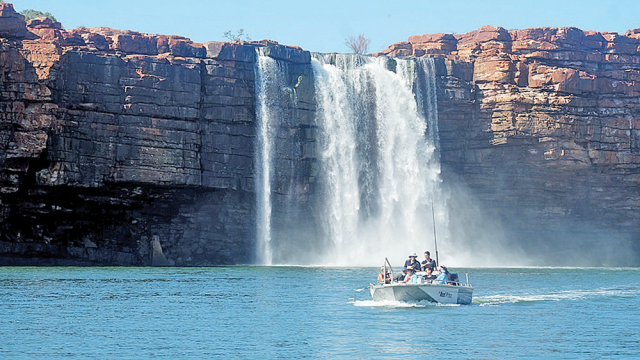To the sound of a dozen jet engines on full throttle, I look up almost 100 metres vertically to see thousands of tonnes of water crashing down onto the rocks almost at my feet.
The water hits the bottom with such force, it generates a wind tunnel of supercharged mist blasting out across the surface of the King George River, creating its own micro-climate within the ancient sandstone amphitheatre.
After nearly 20 years of visiting the remote Kimberley in Australia’s North West, this is the first time I’ve ever been as early as March when the rivers are in peak flow after the annual wet season deluge. It’s a natural phenomenon of immense proportions, yet witnessed by only a few score visitors every year.
“WE’RE VERY FORTUNATE TO SEE THE FALLS IN SUCH STAGGERING FURY,” yells Paul above the din. It’s true. By the time many of the major international operators arrive in late May, most of the Kimberley waterfalls will have shrunk to a comparative trickle. Others will have disappeared altogether.
On this ‘Waterfall Day’ near the highest point of Western Australia, Paul is able to show us 10 properly functioning waterfalls, most I have never seen before with or without water.

The Kimberley Basin, with almost 50 named rivers, accounts for three quarters of the state’s total discharge. The largest river in the region, the Fitzroy near Derby, will discharge 9000 gigalitres per year on average, but has been recorded pouring out a massive 30,000,000 litres per second when in peak flood. Average annual rainfall can be up to 1500mm, but conditions vary wildly and that amount and more was recorded in just a month at Kuri Bay as recently as 2022.
If you’ve been watching the news of late, you’ll know that ridiculous amounts of water have been falling in the Kimberley and all across the Top End recently, often accompanied by strong tropical storms. Whole towns have been evacuated, but the silver lining (if you can say that) is that the waterfalls are in outrageous display.
The so-called Waterfall Season in the Kimberley typically takes place from March when the local vessels like Reef Prince reposition from Fremantle with specially devised itineraries to capitalise on on nature’s annual spectacular. Depending on the prevailing conditions, the season may persist as late as May.
Oh, by the way, I’m aboard the 36-passenger Reef Prince, the sole vessel of Kimberley Expeditions, for their 12-day Broome to Darwin itinerary.
Reef Prince began life in 1995 on the Great Barrier Reef as a fast ferry and day boat and was bought by the entrepreneurial couple, Steve and Deb Garner, who are based at Mataranka Station in the Northern Territory. After a major refit, the couple have run the vessel in the Kimberley since 2017.

Reef Prince runs four aluminium-hulled tenders of the same design favoured by many of the local operators. Metal hulls, I am told, are more durable in this harsh environment where sharp rocks and other less predictable hazards abound.
Each are powered by lusty 140hp Suzuki outboards except for the flagship sightseeing vessel, Regent, which runs twin 140s and can motor at more than 40 knots when urged. Their surplus of power is welcome when tackling the wild torrents of Talbot Bay’s notorious Horizontal Falls.
On board, the main deck has the combined dining room and lounge and is also where Paul Hogger, our ebullient expedition leader, gives his briefings and talks.
French chef, Gigi, also demonstrates his expert culinary skills here and as the journey progresses, we come to understand why he’s held in such high regard.
The rear deck is the marina where tenders are loaded from a platform at water level and the bow has a delightful airy space with comfy couches for watching the ancient panorama roll past.
It’s not too late to book your 2024 Kimberley adventure and experience something unique for your next holiday.
For more details, contact Kimberley Expeditions on 1300 874 707 or visit http://www.kimberleyexpeditions.com.au.

Roderick Eime
Roderick Eime is a veteran travel and tourism journalist, broadcaster and photographer who has travelled the world for more than 40 years. He has explored every continent, sailed every ocean, and visited almost 100 countries. He has contributed to Western Weekender for more than 10 years and is regularly heard on ABC Radio.

